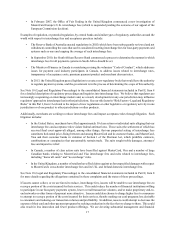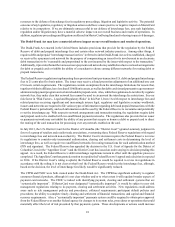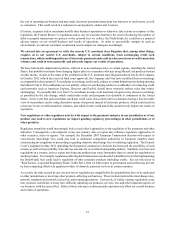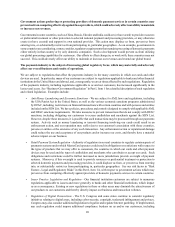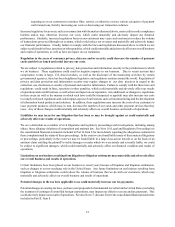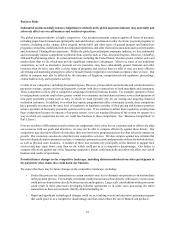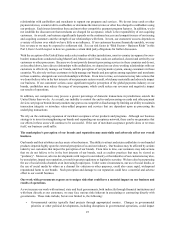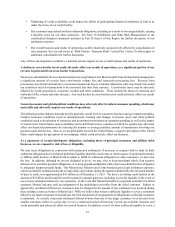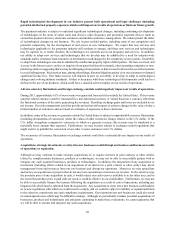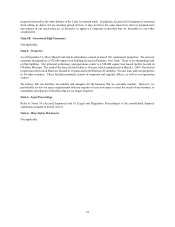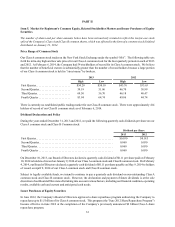MasterCard 2013 Annual Report Download - page 28
Download and view the complete annual report
Please find page 28 of the 2013 MasterCard annual report below. You can navigate through the pages in the report by either clicking on the pages listed below, or by using the keyword search tool below to find specific information within the annual report.24
If we lose a significant portion of business from one or more of our largest customers, our revenue could fluctuate
and decrease significantly in the longer term, which could have a material adverse long-term impact on our
business.
Most of our customer relationships are not exclusive and in certain circumstances may be terminated by our customers.
Our customers can reassess their commitments to us at any time in the future and/or develop their own competitive
services. Accordingly, our business agreements with these customers may not reduce the risk inherent in our business
that customers may terminate their relationships with us in favor of relationships with our competitors, or for other
reasons, or might not meet their contractual obligations to us.
In addition, a significant portion of our revenue is concentrated among our five largest customers. Loss of business
from any of our large customers could have a material adverse impact on our overall business and results of operations.
Merchants continue to be focused on the costs of accepting electronic forms of payment, which may lead to
additional litigation and regulatory proceedings and may increase the costs of our incentive programs, which
could materially and adversely affect our profitability.
Merchants are an important constituency in our payments system. We rely on both our relationships with them, as well
as their relationships with our issuer and acquirer customers, to expand the acceptance of our cards and payment devices.
We also work with merchants to help them enable new sales channels, create better purchase experiences, improve
efficiencies, increase revenues and fight fraud. In the retail industry, there is a set of larger merchants with increasingly
global scope. We believe that these merchants are having a significant impact on all participants in the global payments
industry, including MasterCard. Some large merchants have supported the legal, regulatory and legislative challenges
to interchange fees that MasterCard has been defending, including the U.S. merchant litigations as to which the Company
recently entered into a settlement agreement (which has received final court approval). See our risk factor in this Part
I, Item 1A with respect to interchange fees and related practices receiving significant and increasingly intense legal,
regulatory and legislative scrutiny worldwide. Also see our risk factor in “Risk Factors - Legal and Regulatory Risks”
in this Part I, Item 1A with respect to the Dodd-Frank Act. The continued focus of merchants on the costs of accepting
various forms of payment may lead to additional litigation and regulatory proceedings.
Merchants are also able to negotiate incentives from us and pricing concessions from our issuer and acquirer customers
as a condition to accepting our payment cards and devices. As merchants consolidate and become even larger, we may
have to increase the amount of incentives that we provide to certain merchants, which could materially and adversely
affect our results of operations. Competitive and regulatory pressures on pricing could make it difficult to offset the
costs of these incentives.
Certain customers have exclusive, or nearly exclusive, relationships with our competitors to issue payment
products, and these relationships may adversely affect our ability to maintain or increase our revenues and may
have a material adverse impact on our business.
Certain customers have exclusive, or nearly-exclusive, relationships with our competitors to issue payment products,
and these relationships may make it difficult or cost-prohibitive for us to do significant amounts of business with them
to increase our revenues. In addition, these customers may be more successful and may grow faster than the customers
that primarily issue our cards, which could put us at a competitive disadvantage. Furthermore, we earn substantial
revenue from customers with nearly-exclusive relationships with our competitors. Such relationships could provide
advantages to the customers to shift business from us to the competitors with which they are principally aligned. A
significant loss of our existing revenue or transaction volumes from these customers could have a material adverse
impact on our business.
We depend significantly on our relationships with our issuers and acquirers to manage our payments system.
If we are unable to maintain those relationships, or if our issuers and acquirers are unable to maintain their
relationships with cardholders or merchants that accept our products for payment, our business may be
materially and adversely affected.
While we work directly with many stakeholders in the payments system, including merchants and governments, we
are, and will continue to be, significantly dependent on our relationships with our issuers and acquirers and their further





